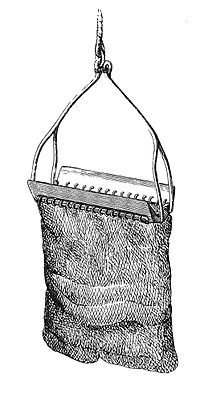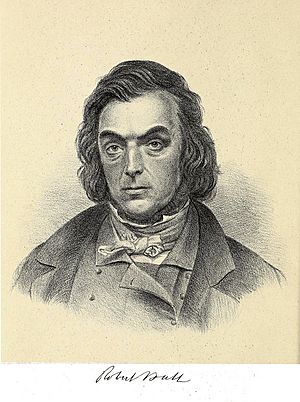Robert Ball (naturalist) facts for kids
Quick facts for kids
Robert Ball
|
|
|---|---|
 |
|
| Born | 1 April 1802 |
| Died | 30 March 1857 (aged 54) 3 Granby Row, Dublin
|
| Nationality | Irish |
| Known for | developing "Ball's dredge" |
Robert Ball (born April 1, 1802 – died March 30, 1857) was an Irish naturalist. A naturalist is someone who studies nature, like plants and animals. He was the Director of the Dublin University Museum. He also invented a special tool called "Ball's dredge" to collect sea creatures. For 20 years, he was a secretary for the Royal Zoological Society of Ireland. He loved sharing his knowledge and helped many people learn about nature.
Contents
Robert Ball's Early Life and Education
Robert Ball was born in Queenstown, County Cork, Ireland. He was the third child in his family. His father, Bob Stawell Ball, worked for customs. His mother was Mary Ball.
The Ball family lived in Youghal, County Cork. Robert had two sisters, Anne and Mary. Both of them also loved studying nature. Anne became known for studying algae, and Mary was an expert on insects.
Robert first went to school in Clonakilty. Later, he attended a Quaker school in Ballitore, County Kildare. His teacher, James White, encouraged his interest in nature. This helped him develop his passion for natural history.
Robert Ball's Career and Discoveries
In 1824, Robert returned to Youghal to work as a magistrate. This job involved a lot of travel, which helped him collect many nature specimens. He moved to Dublin in 1827.
He worked in the civil service for 20 years. This job was not his favorite, but he still found time for his love of nature. He met many other scientists in Dublin.
In 1844, Robert Ball became the Director of the Dublin University Museum. Later that year, he also became Director of the Museum in Trinity College. He gave his collection of 7,000 bird skins to the museum.
He was also the secretary for the Royal Zoological Society of Ireland from 1837 to 1857. He made the zoo more accessible to everyone. People could visit for just one penny on Sunday afternoons.
What Was Ball's Dredge?
Around 1838, Robert Ball created a special net called a dredge. He used it to collect living things from the bottom of the sea. This tool became known as "Ball's dredge."
His dredge was very effective and was used all over the world. It had a rectangular net attached to a long, flat frame. It was designed to prevent the collected items from washing out.
Robert Ball's Family Life
On September 21, 1837, Robert Ball married Amelia Gresley Hellicar. They met at a science meeting in Bristol. They had four daughters and three sons.
His sons also became well-known in science. Sir Robert Stawell Ball became an astronomer. Valentine Ball was a geologist and naturalist. Sir Charles Bent Ball was a surgeon and botanist. Robert also supported his sister Mary in her insect studies.
Robert Ball's Contributions to Science
Robert Ball did not publish many papers, only about 10 in total. However, he was very important in sharing scientific knowledge. He started public lectures, especially at the Dublin Zoo. He even gave many of these lectures himself.
He made sure his sisters' collections were preserved. Anne's algae and Mary's insects went to the university museum. He also helped his sister Mary publish her work on water bugs, giving her full credit.
Images for kids






